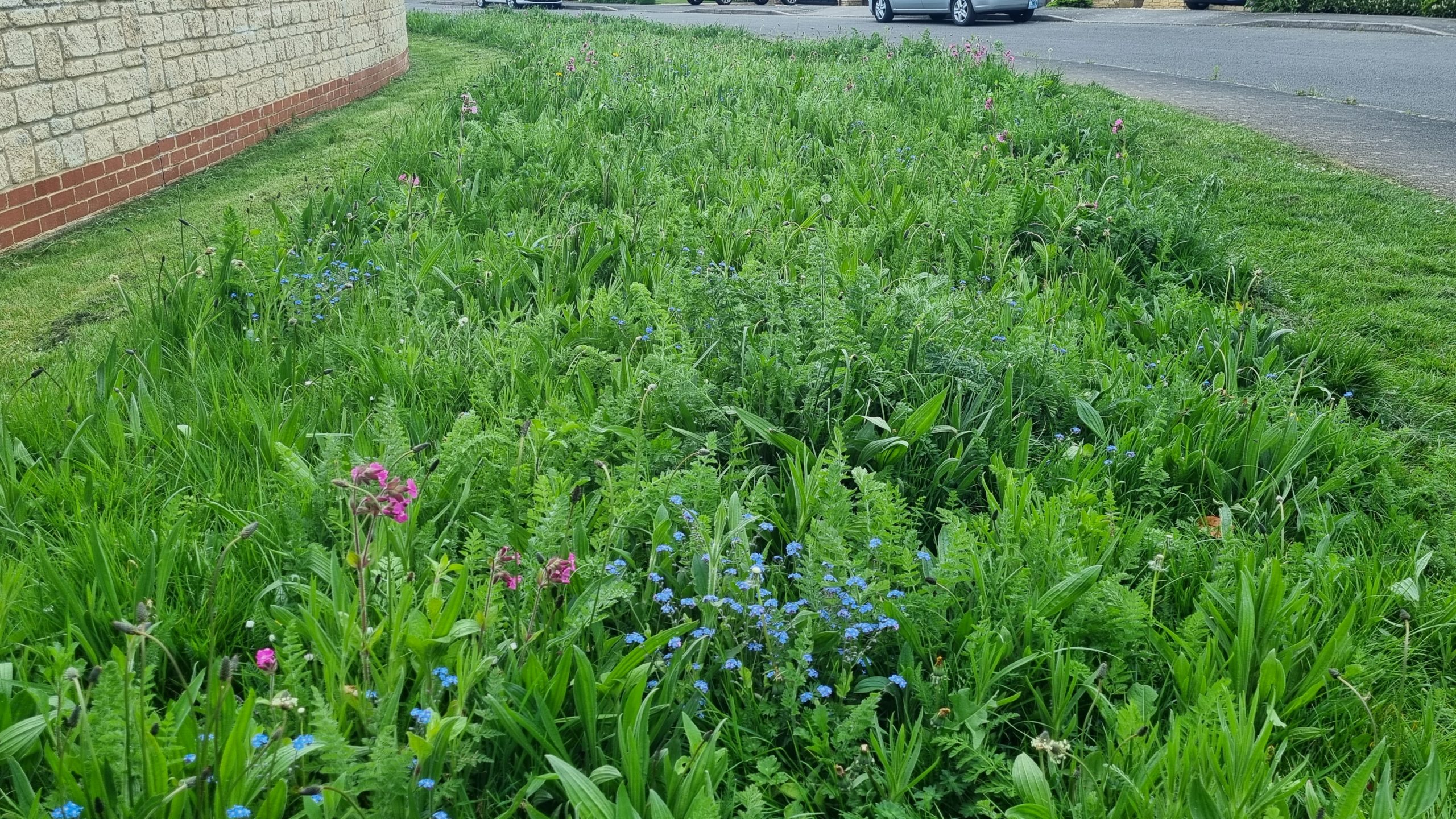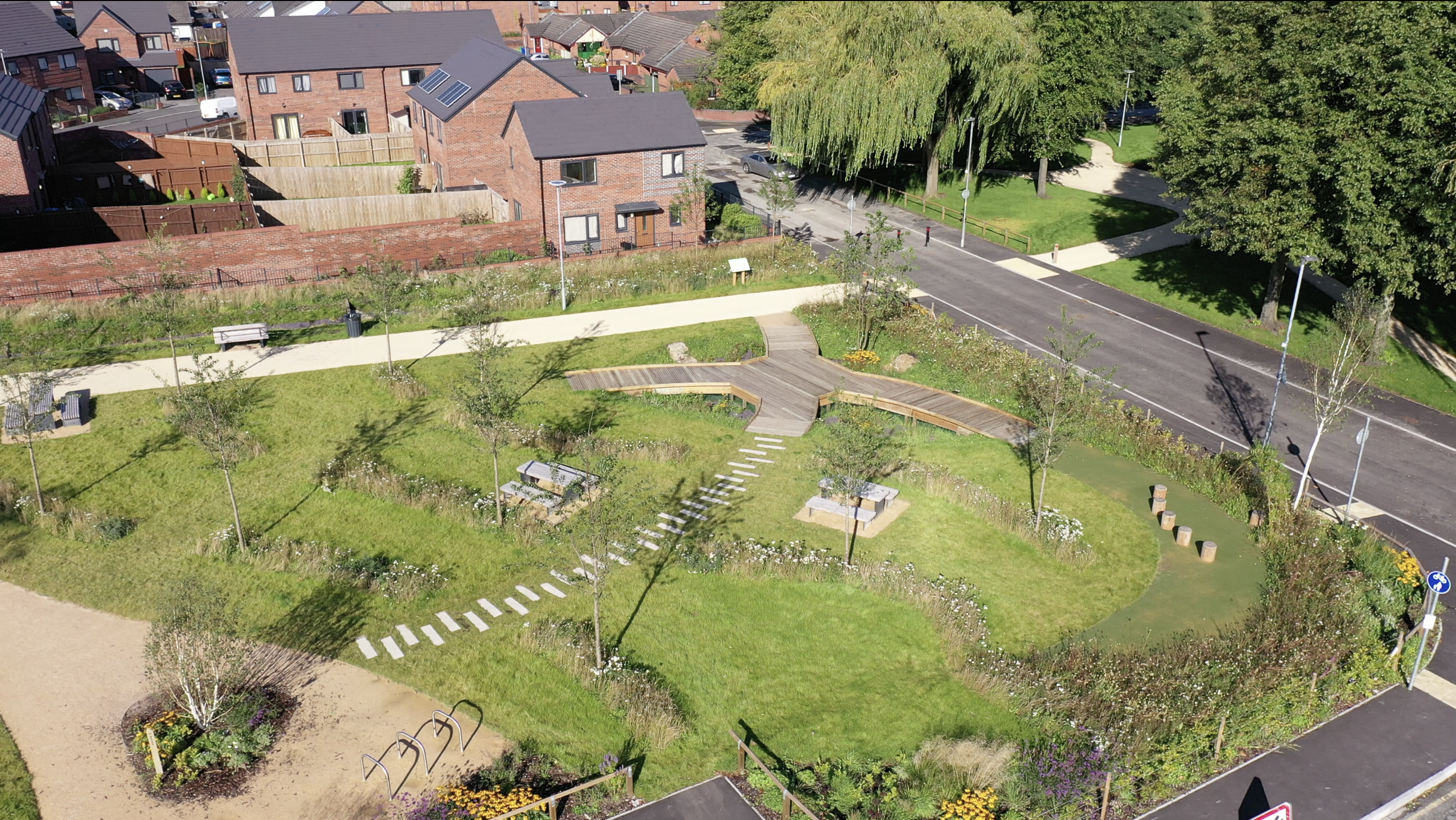Key Opportunity 6: Making the most of our parks and open spaces (including biodiversity enhancements)

Purpose
Repurpose green spaces to allow for multiple functions, including habitat creation, reducing flood risk and growing food.
Description
Too often, parks and green spaces are designed with a single function in mind. Particularly given the scarcity of open space, there is a need to start delivering more multifunctional open spaces. Those functions might include biodiversity value, energy production, natural play, recreation and floodwater storage.
These green spaces are found at various scales – from Country Parks to roadside verges and roundabouts. It also includes school grounds and privately owned spaces such as golf courses and private gardens.
One key way of increasing biodiversity value can include changing the mowing regimes within existing grass areas to allow for more ‘wild’ habitats and wildflowers. This can provide habitats for insects, birds and mammals and help to address the ongoing decline in pollinators.
By simply leaving grass to grow tall by changing mowing regimes, reducing the use of fertilisers and pesticides, and sowing wildflower seeds; grasses and wildflowers can be encouraged to flower and seed open grassy spaces. This can apply in both rural areas and within settlements.
There is also increasing attention on the use of green space for water storage in areas of high flood risk, as part of a strategy to create ‘sponge towns’ as a nature-based solution (NBS) to climate resilience.
While it lies outside the planning system, the delivery of this type of opportunity is likely to require a significant change in how agricultural land is managed for biodiversity across Cherwell. This is likely to take place in coordination with Defra and as part of wider Environmental land management (ELMS) schemes, which are intended to support the rural economy while achieving the goals of the 25 Year Environment Plan and the UK’s commitment to net zero emissions by 2050.
Why is this important for Cherwell?
Cherwell’s existing green spaces can do more to provide multiple functions that would strengthen the GBI network.
As highlighted in the Nature pages, despite Cherwell’s semi-rural nature and relative abundance of open space, many of those landscapes are failing to provide an environment in which biodiversity can thrive. This is in part due to the dominance of intensive agriculture, which is causing fragmentation of habitat networks.
Significantly expanding Cherwell’s species-rich grassland areas will be vital in building a nature recovery network. This will also provide opportunities to ‘hold water’ in the landscape to reduce flood risk (see Key Opportunities 1 and 2).
With development pressures on Cherwell increasing, rethinking the functions of open spaces across the District will be important in ensuring that they provide maximum benefits for people, nature and place.
Case studies: Oxford road verges, West Gorton Community Park and Community Orchard in Bicester
In 2021 Oxford City Council reviewed its existing grass verges to determine if the number of long grass verges could be increased in an effort to increase their biodiversity value – providing nectar resources for pollinators.
Prior to 2021, most verges in Oxford City were mown every 15 working days between March and October (the growing season). Following the review, verges in 26 locations were selected and allowed to grow longer, with a single cut in late summer 2021. Cuttings were also removed to reduce the nutrients in the grassland and further encourage greater species diversity. Where there are highway junctions, a section of grass was maintained at a lower height for motorist, cyclist and pedestrian sight lines.
The West Gorton Community Park (known as the ‘sponge park’) in Manchester provides an example of a multifunctional green space that act like a ‘sponge’ in areas of flood risk whilst also simultaneously providing recreational and biodiversity value. It was delivered alongside housing development by a range of public and private partners.
West Gorton Community Park (Image Source: Groundwork)

Closer to home, in August 2012 local community group Grassroots Bicester was given permission by Bicester Town Council to manage the Langford Community Orchard. The one-acre site was originally farmland but was planted with fruit trees and bushes when Langford Village was first built. After falling into neglect for many years, in 2012 the community began rescuing the fruit trees and plans to plant a wildflower garden.
Further guidance
Considerations will vary significantly depending on the nature of the functions that a green space provides.
In the case of existing parks, the National Lottery Heritage Fund (NLFH) provides a series of guidance documents on various topics. In particular, guidance on nature and landscapes, environmental sustainability, skills and training and local areas may be particularly useful for guiding the management of green spaces for GBI.
Plantlife have produced Best Practice Guidance for the management of road verges for wildlife. This is based on the overall principle of ‘cut less, cut later’.
In the case of all green spaces, a key consideration will be investing time in communicating the changes with the local community. This will ensure ‘buy in’ from the local community and avoid complaints – e.g. to overcome the risk of ‘wilder’ grass areas being viewed as unkempt.
Key delivery partners
- Wild Oxfordshire
- Plantlife
- The RSPB
- National and local highways authorities
- Local Parks and Open Spaces teams
- The Berks, Bucks & Oxon Wildlife Trust (BBOWT)
- Groundwork
- Local communities and Councillors
- Town and parish councils
Potential delivery mechanisms
- Simple changes to mowing regimes as part of open space management.
- Local businesses – sponsorship of verges from local businesses as part of Corporate Social Responsibility (CSR) initiatives.
- Multifunctional spaces delivered as part of regeneration projects.
- Multifunctional open spaces designed into new development (see Guidance for new development).
- Developer contributions to cover the cost of managing urban/rural verges.
- Community asset transfer – allowing community groups to steward grassed areas for wildlife.
- Alternative management structures for green spaces – e.g. Trusts.